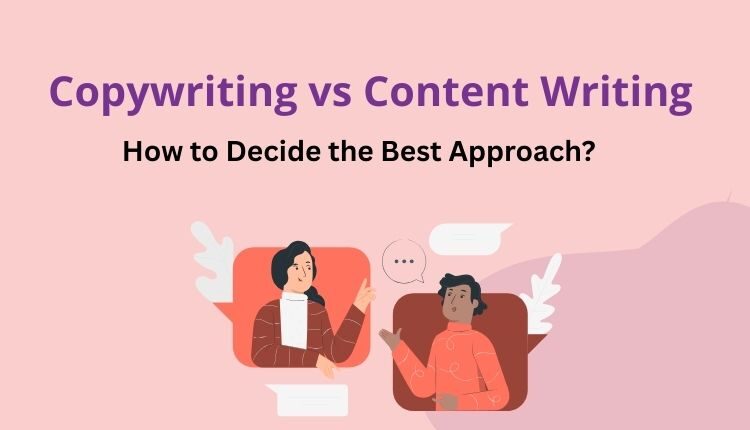In today’s content-driven world, understanding the difference between copywriting and content writing is essential for students, researchers, educators, and professionals striving to produce impactful written material. While both play a crucial role in various marketing and communication strategies, their purposes, tone, and techniques differ significantly.
Below, we’ll break down the distinctions, provide examples, and help you decide whether copywriting or content writing aligns with your objectives.
Copywriting: The Art of Persuasion
Copywriting is all about persuasion. It focuses on driving immediate actions, such as making a purchase, signing up for a service, or clicking on a link. If you recall seeing a catchy ad that made you buy something on the spot—that’s quality copywriting at work.
Examples of Copywriting:
- Advertisements (print, web, and social media)
- Taglines and slogans
- Landing pages
- Sales-focused emails
- Paid ads (e.g., PPC)
- Jingle lyrics and commercials
Key Features of Copywriting:
- Purpose: Persuade users to take specific, actionable steps.
- Tone: Engaging, compelling, and often urgent.
- Platform: Frequently found in promotional campaigns.
- Skillset Needed: Marketing knowledge, consumer psychology, and creative storytelling.
Example: A tagline like “The ultimate AI grammar checker designed to simplify your academic projects!” is persuasive, action-driven copy designed to evoke immediate interest.
Insights About Copywriting:
– Copywriters work for marketing teams, advertising firms, or freelance for clients creating materials such as ad copy or sales letters.
– Common frameworks like AIDA (Attention, Interest, Desire, Action) help copywriters structure campaigns to guide readers through a buying journey.
Content Writing: Educate, Inform, and Build Trust
While copywriting aims for direct action, content writing focuses on delivering value over time. It involves creating long-form, engaging content that informs the audience, strengthens credibility, and builds trust. Success stems from its ability to develop a sustained relationship with readers.
Examples of Content Writing:
- Blog posts and articles
- How-to guides or tutorials
- Case studies and whitepapers
- Academic essays or educational scripts
- Informative social media posts
Key Features of Content Writing:
- Purpose: Educating, informing, or entertaining rather than direct selling.
- Tone: Authoritative, instructional, or sometimes conversational.
- Platform: Often used in blogs, resource centers, and long-format media.
- Skillset Needed: Research skills, storytelling, and mastery of the narrative structure.
Example: A blog titled “Top AI Tools to Improve Academic Writing” aims to engage readers and provide helpful insights, establishing long-term trust with the audience.
Key Differences Between Copywriting and Content Writing
Here’s a side-by-side comparison to highlight their distinctions:
| Aspect | Copywriting | Content Writing |
|---|---|---|
| Primary Goal | Generate immediate action (purchase, click). | Offer long-term value and build credibility. |
| Examples | Sales emails, ads, taglines. | Blog posts, eBooks, academic guides. |
| Tone | Persuasive, energetic, and urgent. | Informative, friendly, or formal depending on the audience. |
| Metrics for Success | Measured by actions taken (clicks, sales). | Measured through audience retention, shares, and SEO performance. |
| Approach | Short, snappy, and action-focused. | Research-intensive and detail-oriented. |
If a company wants to sell a product, they’ll create a landing page using copywriting techniques. If they want to educate the audience, they’ll release a how-to guide using content writing strategies.
Balancing Copywriting and Content Writing
The line between these two disciplines frequently overlaps. For example:
- Blog posts may include calls-to-action (CTAs) such as “Download the free grammar checker now!”—a technique borrowed from copywriting.
- Social media posts often mix engaging content with promotional elements.
For writers, mastering both is an advantage. Blending copywriting principles into an educational blog or combining informational value in sales copy ensures success in today’s dynamic environment.
Trinka’s Role in Crafting Superior Copy and Content
For writers striving for polished material, Trinka AI is a game-changer. Trinka excels in improving accuracy, grammar, tone consistency, and making both copy and content error-free and impactful.
Enhance Your Copywriting:
- Use tools like Trinka’s persuasion tone analysis to refine your tone and increase engagement.
- Build concise taglines by experimenting with paraphrasing features for clarity.
Enhance Your Content Writing:
- Trinka’s research consistency checker ensures academic and technical accuracy for in-depth content.
- Its AI-powered grammar checker polishes posts for SEO-friendly structure and readability.
When to Use Copywriting vs. Content Writing
1. What’s Your Purpose?
– For immediate actions like sales or sign-ups, go for copywriting.
– If you’re building audience relationships, opt for content writing.
2. Who Is Your Audience?
– Copywriting aligns with niche, action-ready groups (e.g., buyers).
– Content writing is best for broader audiences seeking value.
3. How Do You Measure Success?
– Use click-through rates (CTR) and conversion metrics for copywriting.
– Track organic traffic and engagement for content writing.
Conclusion
Mastering copywriting or content writing—or, better yet, combining both—empowers writers to build impactful materials tailored to different audiences and goals. Success lies in your ability to identify the intent behind each use case.
With tools like Trinka AI at your disposal, whether you’re driving sales with compelling ad copy or educating audiences through blog posts, you’ll create content that resonates, persuades, and builds lasting connections.

